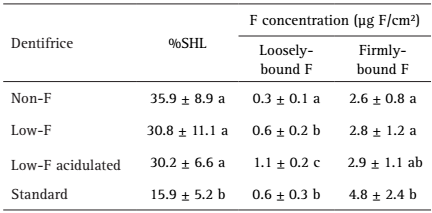Abstract
Low-fluoride (F) dentifrices (<600 µg F/g) are widely available worldwide, but evidence to recommend the use of such dentifrices, with either regular or improved formulations, is still lacking. Therefore, the aim of this study was to evaluate the anticaries potential of low-F dentifrices found in the Brazilian market, using a validated and tested pH-cycling model. Enamel blocks were selected by surface hardness (SH) and randomized into four treatment groups (n=12): non-F dentifrice (negative control), low-F dentifrice (500 μg F/g), low-F acidulated dentifrice (550 μg F/g) and 1,100 μg F/g dentifrice (positive control). The blocks were subjected to pH-cycling regimen for 8 days and were treated 2x/day with dentifrice slurries prepared in water (1:3, w/v). The pH of the slurries was checked, and only the acidulated one had low pH. After the pH cycling, SH was again determined and the percentage of surface hardness loss was calculated as indicator of demineralization. Loosely- and firmly-bound F concentrations in enamel were also determined. The 1,100 μg F/g dentifrice was more effective than the low-F ones to reduce enamel demineralization and was the only one that differed from the non-F (p<0.05). All F dentifrices formed higher concentration of loosely-bound F on enamel than the non-F (p<0.05), but the 1,100 μg F/g was the only one that differed from the non-F in the ability to form firmly-bound F. The findings suggest that the low-F dentifrices available in the Brazilian market, irrespective of their formulation, do not have anticaries potential.
Key Words:
fluorides; toothpaste; dental caries; demineralization



